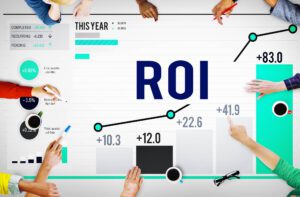How to Measure the ROI of Your Digital Marketing Campaigns
Are you tired of pouring time and money into your digital marketing campaigns without seeing tangible results? It’s time to take control and measure the return on investment (ROI) of your efforts. In this blog post, we will show you how to track and analyze the success of your digital marketing campaigns so you can make informed decisions that drive real growth for your business. Say goodbye to guessing games and hello to data-driven strategies that deliver results!
Introduction: Why measuring ROI is important for digital marketing campaigns
Are your digital marketing efforts paying off? It’s time to dive deep into the world of ROI and uncover the secrets to measuring success in your campaigns. Get ready to unlock the power of data and make informed decisions that drive real results! Let’s explore how you can effectively measure the ROI of your digital marketing campaigns and take your strategies to new heights.
ROI (return on investment) is a crucial metric in determining the success of any marketing campaign, including digital marketing. It refers to the amount of profit or revenue generated from an investment compared to the cost of that investment. In simpler terms, ROI measures how much money you have gained or lost from your marketing efforts.
What is ROI and why it matters in digital marketing
ROI, or Return on Investment, is a crucial metric in digital marketing. It represents the effectiveness of your campaigns in generating revenue compared to the cost involved. In simpler terms, it shows you how much bang you’re getting for your buck in the digital realm.
Understanding ROI is essential because it helps you evaluate the success and impact of your marketing efforts with concrete numbers. By measuring ROI, you can determine which strategies are yielding positive results and which ones may need adjustments.
Having a clear grasp of ROI allows businesses to make informed decisions about where to allocate their resources for maximum profitability. It enables them to optimize their marketing tactics based on data-driven insights rather than guesswork or intuition alone.
In essence, ROI matters in digital marketing because it provides a quantifiable way to assess performance, identify opportunities for growth, and ensure that every penny spent contributes positively towards achieving business objectives.
Key metrics to track for measuring ROI
When it comes to measuring the ROI of your digital marketing campaigns, tracking key metrics is essential for understanding the performance and success of your efforts. One crucial metric to monitor is conversion rate, which shows how many visitors take a desired action on your website. By analyzing this data, you can evaluate the effectiveness of your campaign in driving conversions.
Another important metric is customer acquisition cost (CAC), which calculates how much it costs to acquire a new customer through your marketing initiatives. Keeping an eye on this metric helps you determine the efficiency of your budget allocation and identify areas for improvement.
Furthermore, monitoring return on ad spend (ROAS) allows you to assess the revenue generated from each dollar spent on advertising. This metric provides valuable insights into the profitability of your campaigns and helps optimize future investments for better returns.
Tools and methods for tracking ROI in digital marketing campaigns
Tracking the return on investment (ROI) of your digital marketing efforts is crucial for understanding the effectiveness of your campaigns. To ensure accurate measurement, utilizing tools like Google Analytics can provide valuable insights into website traffic, conversion rates, and revenue generated. Additionally, implementing UTM parameters in your URLs enables you to track specific campaign performance across different channels.
Email marketing platforms offer tracking capabilities that allow you to monitor open rates, click-through rates, and ultimately conversions from email campaigns. Social media management tools can help track engagement metrics such as likes, shares, comments, and clicks to measure the impact of social media initiatives. Furthermore, customer relationship management (CRM) systems provide a comprehensive view of customer interactions and conversions attributed to various marketing channels.
By leveraging these tools and methods effectively in combination with clear goal setting and KPIs alignment…
Case studies or examples of successful ROI measurement in digital marketing campaigns
Imagine a clothing brand that invested in targeted social media ads to promote their new collection. By tracking the ROI, they discovered that their sales increased by 30% during the campaign period. This success was attributed to reaching the right audience at the right time with compelling visuals and messaging.
Another example is a software company that utilized email marketing to nurture leads and drive conversions. Through careful monitoring of ROI metrics, they found that for every $1 spent on email campaigns, they generated $38 in revenue. This highlighted the effectiveness of personalized content and strategic timing in engaging potential customers.
A travel agency decided to implement influencer partnerships to boost brand awareness and bookings. By analyzing the ROI data, they saw a significant uptick in website traffic and bookings directly linked to influencer posts. This demonstrated the power of leveraging influencers’ reach and credibility to drive tangible results for their business.
These case studies illustrate how measuring ROI can provide valuable insights into the effectiveness of digital marketing strategies, enabling businesses to make informed decisions for future campaigns based on concrete data points.
Common mistakes to avoid when measuring ROI
When it comes to measuring the ROI (return on investment) of your digital marketing campaigns, there are certain mistakes that many businesses make which can affect the accuracy and effectiveness of their measurements. By avoiding these common mistakes, you can ensure that your ROI analysis is more reliable and provides valuable insights for future campaign planning.
1. Not Setting Clear Goals: The first mistake to avoid is not setting clear goals for your digital marketing campaign. Without a clear understanding of what you want to achieve, it becomes difficult to measure whether or not you have achieved a positive return on your investment. Make sure to establish specific and measurable goals before launching any campaign.
2. Focusing Only on Monetary Metrics: While revenue and sales are important metrics in determining ROI, they should not be the only ones considered. Often times, other key performance indicators (KPIs) such as website traffic, engagement rates, and lead generation can also contribute significantly to the overall success of a campaign.
3. Neglecting Attribution: Attribution is the process of assigning credit to different channels or touchpoints that contribute to a conversion or sale. Many businesses make the mistake of giving all credit solely to the last click or conversion when measuring ROI. This can result in inaccurate data and undervaluing certain channels that may have played a crucial role in driving conversions.
4. Not Tracking Conversions Properly: In order to accurately measure ROI, it’s essential to properly track conversions from each channel or campaign. This means setting up conversion tracking codes for your website and ensuring they are working correctly so that all conversions are accounted for in your analysis.
5. Ignoring Time Lag: It’s important to consider time lag when analyzing ROI as some campaigns may take longer than others to generate results or see an impact on revenue/sales. Avoid making hasty conclusions about a campaign’s success without taking into account any potential time lag effects.
6. Comparing Incompatible Data Sets: When measuring ROI, it’s crucial to compare data from the same time period and with similar variables. Comparing data from different time periods or campaigns with varying objectives can skew your results and give an inaccurate picture of your return on investment.
By avoiding these common mistakes, you can ensure that your measurements of ROI are accurate and provide valuable insights for future campaign planning. Remember to set clear goals, track conversions properly, consider all relevant metrics, and compare data carefully in order to get a more comprehensive understanding of the success of your digital marketing campaigns.
Tips for maximizing ROI in your digital marketing campaigns
1. Set realistic goals: Before launching any digital marketing campaign, it is important to set achievable and measurable goals. These goals should align with the overall objectives of your business and should be specific, measurable, attainable, relevant, and time-bound (SMART). This will help you measure the success of your campaigns accurately and make necessary improvements.
2. Know your target audience: Understanding your target audience is crucial for any digital marketing campaign. Conduct market research to gain insights into their demographics, preferences, behavior patterns, and interests. Use this information to create targeted and personalized content that resonates with them.
3. Utilize social media platforms effectively: Social media has become a powerful tool for businesses to reach their target audience and increase their ROI. It is important to choose the right platforms based on where your target audience spends most of their time online. Create engaging content, use hashtags strategically, interact with followers regularly, and run paid ads to maximize reach and engagement.
4. Optimize for search engines: Search engine optimization (SEO) plays a vital role in driving organic traffic to your website or landing pages. Make sure your website is optimized for relevant keywords by conducting keyword research and utilizing them in meta descriptions, titles, headers, and throughout the content on your website.
5. Invest in high-quality content: Content is king in the world of digital marketing. Quality content can attract potential customers and keep them engaged with your brand. Create informative blog posts, videos, infographics or any other form of content that adds value to your target audience’s lives.
6. Utilize email marketing: Email marketing is still one of the most effective ways to reach out to potential customers directly. Build an email list through opt-in forms on your website or by offering valuable lead magnets like e-books or webinars.
Conclusion:
Tracking and measuring the ROI of your digital marketing campaigns is crucial for the success of your business. By understanding which strategies are delivering results and which ones need adjustment, you can optimize your marketing efforts for maximum impact.
Remember, ROI is not a one-time calculation but an ongoing process that requires continuous tracking and adjusting. Utilize the key metrics discussed in this article, leverage tools to streamline the tracking process, learn from successful case studies, avoid common mistakes, and implement tips to maximize ROI.




Comments
Post a Comment